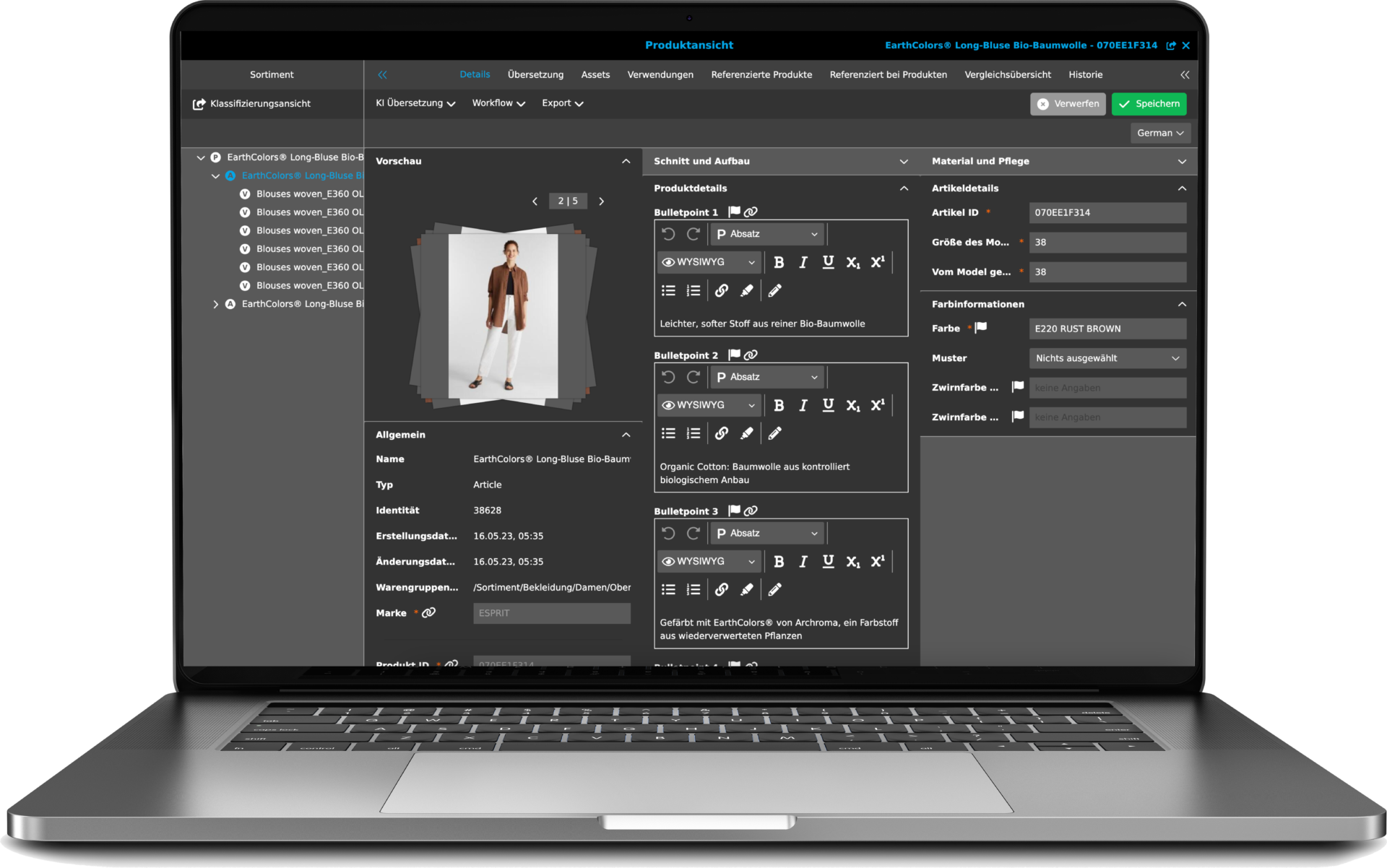PIM vs. PLM: The ultimate decision-making aid for your product management
Product Information Management
Efficient systems for managing product data are essential. Two key terms that are frequently used in this context are Product Information Management (PIM) and Product Lifecycle Management (PLM). Both systems are crucial for product management, but they differ in their functions and areas of application. In this blog article, we take a look at the differences and advantages of PIM and PLM.
What is PIM?
PIM is the abbreviation for Product Information Management. This refers to the management of all product-related information that is relevant for customer communication. The software used here is called a PIM system. It ensures that all communication-relevant product data is managed centrally and is therefore consistent, up-to-date and accessible. PIM systems are connected to various systems (e.g. ERP, DAM system or online shops) for this purpose. PIM systems are particularly useful for companies that sell a variety of products through different channels and need to ensure that all information, such as descriptions, images, specifications and prices, is always up to date.


What is a PLM?
PLM, short for Product Lifecycle Management, is a methodical approach to organising and managing processes and data during the product lifecycle (development, introduction, growth, maturity, saturation and decline). The supporting software is called a PLM system. PLM systems help companies to efficiently manage and optimise the entire product life cycle by connecting product development teams and suppliers and unifying their communication.
PIM vs. PLM: The differences
Although PIM and PLM are both used to manage product data, they differ fundamentally in their focus and functions.
PIM (Product Information Management)
- Focus: PIM concentrates on the management and distribution of marketing and sales information.
- Function: PIM collects, manages and publishes product data.
- Users: PIM is mainly used by marketing and sales teams to generate product information and keep it consistent and up-to-date.
- Data management: PIM systems mainly manage marketing and sales data such as product names, article numbers, descriptions and attributes (size, colour, weight, material, etc.). The products are also placed in relation to each other (cross-selling or up-selling).
- Use: PIM is used after product completion.
- Objective: PIM improves marketing and sales processes.
PLM (Product Lifecycle Management)
- Focus: PLM concentrates on the entire life cycle of a product from development to disposal.
- Function: PLM stores data during development and production.
- Users: PLM is used by development, production and quality management teams to control and optimise the entire product development process.
- Data management: PLM systems manage technical data (e.g. development documents, design and production data), test and quality reports as well as service and maintenance data. You will also find all the information you need on project management and communication.
- Use: PLM is used during development and production.
- Objective: PLM improves product development and manufacturing processes.

To summarise: When a PIM and when a PLM?
Product Information Management (PIM) and Product Lifecycle Management (PLM) are two different systems that each address specific requirements in the management of product data. Roughly speaking, a PIM is needed to market the market-ready product, whereas a PLM supports the management of an idea into a marketable product. Here is an overview of when each of these systems is needed:
When is a PIM system needed?
A PIM system is required when the focus is on the management and provision of product information. Typical scenarios are:
- E-commerce and multichannel marketing: If companies sell their products via different channels (e.g. online stores, marketplaces, social media), a PIM system helps to automatically provide consistent and up-to-date product information across all platforms.
- Management of large product data: Companies with extensive products (many variants, properties, etc.) benefit from a PIM system, as it simplifies the consolidation, organisation and maintenance of this product data and reduces errors.
- Product data updates: If frequent changes to product information are required, a PIM system enables efficient data management and fast communication of current product data.
- International sales: For companies that offer their products in different countries, a PIM system supports the management of multilingual product information and customisation for local markets.
- Product Experience Management: A PIM system is crucial for optimising the product experience across all channels. It is the prerequisite for Product Experience Management, as a PIM system focuses on providing consistent and engaging product information to improve the customer experience during the customer journey and increase the conversion rate.
The advantages of using a PIM:
- Consistency and accuracy: PIM systems ensure that all product information is consistent and correct across all sales channels.
- Efficiency: The centralised management of product data reduces the effort required for data maintenance and increases efficiency.
- Faster time to market: PIM systems make it possible to bring new products to market faster, as all the necessary information is available quickly and easily.
- Better customer loyalty: Consistent and accurate product information allows customers to be better informed, leading to higher customer satisfaction and loyalty.
When is a PLM system needed?
A PLM system is required when the focus is on the entire life cycle of a product, from development through production to retirement. Typical scenarios are:
- Product development and design: Companies that develop complex products benefit from a PLM system that facilitates collaboration between designers, engineers and other stakeholders and optimises the development process.
- Managing product changes: A PLM system helps track changes throughout the product lifecycle, including design changes, material adjustments and production modifications.
- Document management: If extensive documentation and technical specifications need to be managed, a PLM system provides the necessary tools for organising and maintaining these documents.
- Compliance and quality management: In highly regulated industries, a PLM system supports compliance with legal regulations and quality standards by systematically tracking and documenting all relevant processes.
A PLM therefore offers the following advantages:
- Improved product development: PLM systems enable better collaboration between different departments, leading to more efficient development processes and more innovative products.
- Cost reduction: By optimising the entire product life cycle, companies can reduce costs in production and development.
- Increased transparency: PLM systems provide a comprehensive overview of the entire product life cycle, which facilitates decision-making.
- Quality improvement: The centralised management of all product-related information enables quality problems to be identified and rectified at an early stage.
To summarise, PIM systems are ideal for managing and distributing product information across multiple sales channels, while PLM systems are designed to manage the entire product lifecycle from development to retirement. The choice of system depends on the specific requirements and objectives of the company.

PIM plus PLM instead of PIM vs. PLM
PIM and PLM are not isolated systems, but complement each other perfectly. Together, they offer a comprehensive solution for product management that covers both the technical aspects during the development phase and the marketing-relevant product information for the launch phase. By integrating PIM and PLM, companies can increase their efficiency at market launch, optimise the growth phase and extend the maturity and saturation phase. This enables them to maximise their market success right up to the point at which the product has to be withdrawn from the market.
- Seamless data integration: PLM systems generate and manage extensive technical data and specifications during product development. This information (e.g. SKUs, material, dimensions, etc.) can be seamlessly integrated into PIM systems to ensure that all product-related data is consistent and accurate.
- Efficient market launch: By combining PLM and PIM, companies can accelerate the process from product development to market launch. PLM ensures efficient development and production, while PIM ensures that product information is prepared for the market in a timely and appealing manner.
- Improved product quality: The close integration of PLM and PIM enables better quality assurance. Changes and updates made in the PLM system can be automatically transferred to the PIM system so that the latest information is always available.
- Holistic product management: The integration of PLM and PIM gives companies a holistic view of their products – from development to sales. This facilitates decision-making and enables better planning and strategy development.
Ideally, both software solutions, i.e. PIM and PLM, should be linked in order to provide all relevant product data from the PLM to the PIM in a structured manner. The interaction of PLM and PIM eliminates unnecessary, duplicate data maintenance and the exchange of information with a PIM is considerably simplified, resulting in savings of time, money and resources.
Conclusion: PIM vs. PLM
Both PIM and PLM are crucial systems for product management, but with different focuses and areas of application. Whether you consider a PIM or a PLM, perhaps even both, depends on your business requirements. If you sell a large number of products and want to ensure that all product information is consistent, up-to-date and appealing across all your channels, you will benefit from a PIM system. Wenn Sie jedoch den gesamten Lebenszyklus Ihrer Produkte effizient steuern und optimieren wollen, benötigen Sie ein PLM-System.
PIM
- Organising product content in one system
- Bringing products to market faster
- Provide customers with consistently accurate product information
- Automate manual tasks
- Organising product content for omnichannel commerce
PLM
- Improve productivity throughout the entire development process
- Shorten the time it takes to bring products to market
- Increase the quality and benefits of products
- Reduce production costs (now and in the future)
- Creating innovative solutions for the development of new products
If both systems (PLM and PIM) are relevant for you, I recommend combining or integrating both solutions. This not only optimises your development processes (PLM), but also your marketing strategies (PIM), especially during the market launch phase. In this way, you can effectively draw attention to your product and better assert yourself against the competition thanks to an accelerated time-to-market.
We cannot offer you a PLM because we concentrate exclusively on the development of PIM and DAM systems. However, Computerwoche once published an article with the 12 best PLM providers, which you can use as a guide when looking for a PLM system: To the PLM article. But if you need a PIM system, then you’ve come to the right place.
Our specially developed OMN PIM not only fulfils all the PIM functions you need to market your products. It is also equipped with the latest AI technology, for example to automate time-consuming and cost-intensive manual processes (such as the translation of product information) or to create intelligent, SEO-optimised product descriptions. Open interfaces ensure seamless integration of our OMN PIM into existing environments (e.g. online stores, marketplaces, ERP or PLM systems). A proven PIM system of the latest generation! Feel free to contact us if required. Our PIM experts will be happy to advise you and present our OMN PIM to you in a personal and binding demo.

Do you know our PIM system “OMN PIM”?
CONTACT US WITHOUT OBLIGATION AND LET US CONVINCE YOU OF OUR OMN PIM.